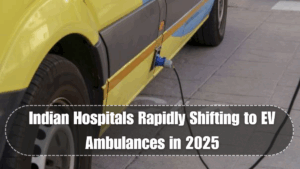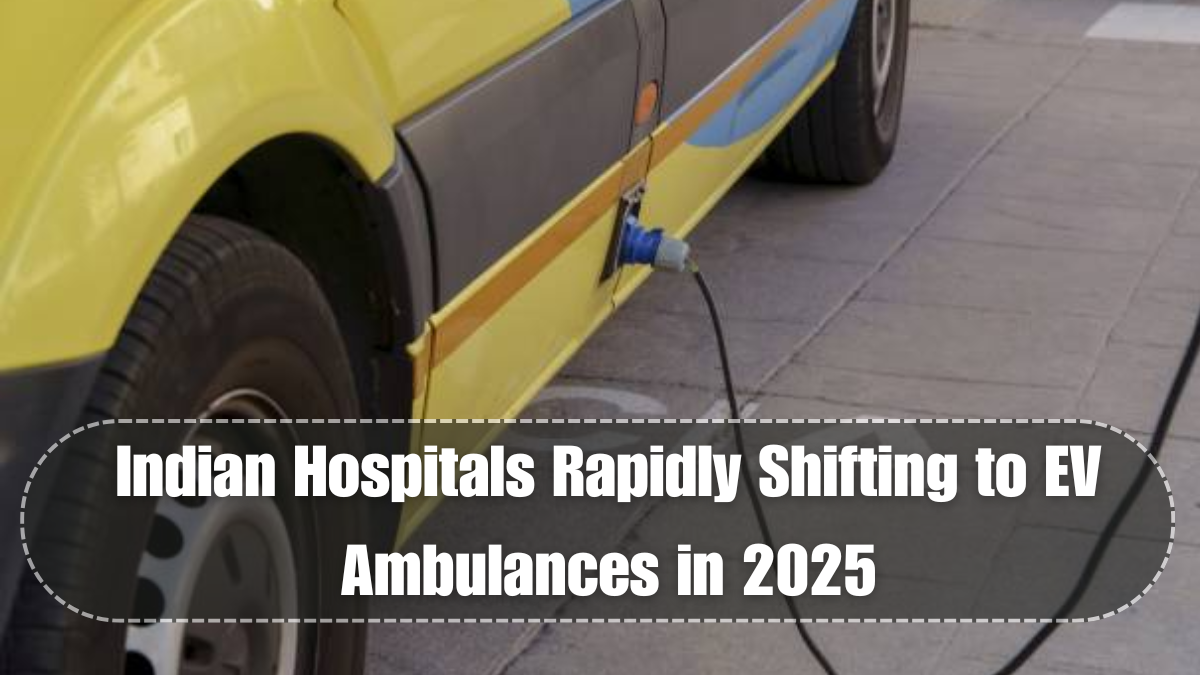The healthcare industry in India is witnessing a major transformation in 2025 with a dramatic rise in hospital EV ambulance adoption. According to IndianPharma’s latest sector report, private and public hospitals in Tier 1 cities are quickly transitioning their ambulance fleets to electric vehicles, recognizing the twin benefits of sustainability and cost-efficiency.
The shift toward EV ambulances is not just an environmental gesture—it’s a calculated move to optimize operations, reduce long-term costs, and support India’s broader goal of cutting healthcare-related emissions. Leading hospitals in cities like Mumbai, Delhi, Bengaluru, and Hyderabad have already added multiple electric ambulances to their green health fleet, with many more preparing for fleet-wide conversions.

What’s fueling the hospital EV ambulance adoption trend?
Several key drivers are behind the growing popularity of EV ambulances in India’s hospital systems:
-
High diesel costs: Traditional ambulance fuel prices have surged, increasing monthly transport budgets by 15–25%.
-
Government incentives: State subsidies and GST reductions on EVs encourage large-scale adoption.
-
Low maintenance: EVs have fewer moving parts and lower maintenance costs compared to diesel ambulances.
-
Noise reduction: EVs offer a quieter operation—ideal for patient comfort and ICU transport.
-
Zero tailpipe emissions: Hospitals can improve their sustainability ratings by adopting a green health fleet approach.
Additionally, the public has responded positively to eco-conscious hospitals. Sustainability-focused patients and NGOs are actively supporting hospitals that embrace hospital EV ambulance adoption strategies.
Features of the new EV ambulance models
The latest generation of EV ambulances deployed in Indian hospitals comes with several advanced features tailored for emergency medical care:
-
Battery backup for 150–200 km range per charge
-
Integrated patient monitors, oxygen ports, and ECG machines
-
Solar panels for auxiliary power support
-
Smart air-conditioning with climate control for patient zones
-
Live vehicle telemetry for real-time hospital coordination
Hospitals are also working with auto-tech firms to add AI-based route optimization and critical patient alert systems in their hospital transport setups.
Comparison Table: Traditional vs. EV Ambulance
| Feature | Diesel Ambulance | EV Ambulance |
|---|---|---|
| Fuel Cost (per month avg) | ₹40,000–₹60,000 | ₹5,000–₹8,000 |
| Maintenance Frequency | High (monthly) | Low (bi-annual) |
| CO₂ Emissions | 200g/km+ | 0g/km |
| Operational Noise | High | Near Silent |
| Average Life Span | 5–6 years | 7–9 years |
| Government Incentives | None | 15% Subsidy + GST Cut |
As seen above, hospital EV ambulance adoption is not only environmentally sound but also economically viable in the long run.
Hospitals leading the shift
Some of the early adopters of EV ambulance technology in India include:
-
Apollo Hospitals (Chennai & Hyderabad) – integrated solar-powered EVs with ICU-level setup
-
Fortis Healthcare (Delhi NCR) – added 10 EV ambulances in 2025 alone
-
Tata Memorial Hospital (Mumbai) – introduced 100% green transport plan for all intra-city patient transfers
-
Manipal Hospitals – working with EV startups for custom-built electric ambulance designs
These institutions have shown that hospital transport need not come at the cost of sustainability. Their models are already being replicated by district hospitals and smaller healthcare units in Tier 2 cities.
Challenges & road ahead
Despite strong momentum, the hospital EV ambulance adoption journey is not without hurdles:
-
Charging infrastructure still remains patchy outside major cities
-
High upfront cost (₹18–22 lakh per EV ambulance) is a barrier for smaller hospitals
-
Training drivers and staff to handle EV systems is essential
-
Limited third-party service centers for emergency repairs
However, IndianPharma projects that by the end of 2026, over 35% of hospital ambulances in Tier 1 cities will be electric—marking one of the fastest adoptions in the global healthcare space.
Government programs such as FAME-II (Faster Adoption and Manufacturing of Electric Vehicles) are also being extended to include hospital fleets, making green health fleet planning easier for large institutions.
FAQs
What is hospital EV ambulance adoption?
It refers to the shift by Indian hospitals from diesel-powered ambulances to electric vehicles to ensure sustainable and cost-effective hospital transport.
Are EV ambulances reliable for emergency use?
Yes, the latest EV ambulance models come with medical-grade equipment, long battery life, and advanced monitoring tools for critical care.
Do hospitals get any incentives for using EV ambulances?
Yes, there are central and state-level subsidies, GST benefits, and special green credits available for hospital EV ambulance adoption.
What are the operational advantages?
EV ambulances offer low maintenance, reduced fuel cost, zero emissions, and a quieter patient transport experience.
Are EV ambulances being used in public hospitals too?
Yes, while private hospitals lead the trend, government hospitals in cities like Pune, Ahmedabad, and Kochi have started pilot projects as well.
Click here to know more.
